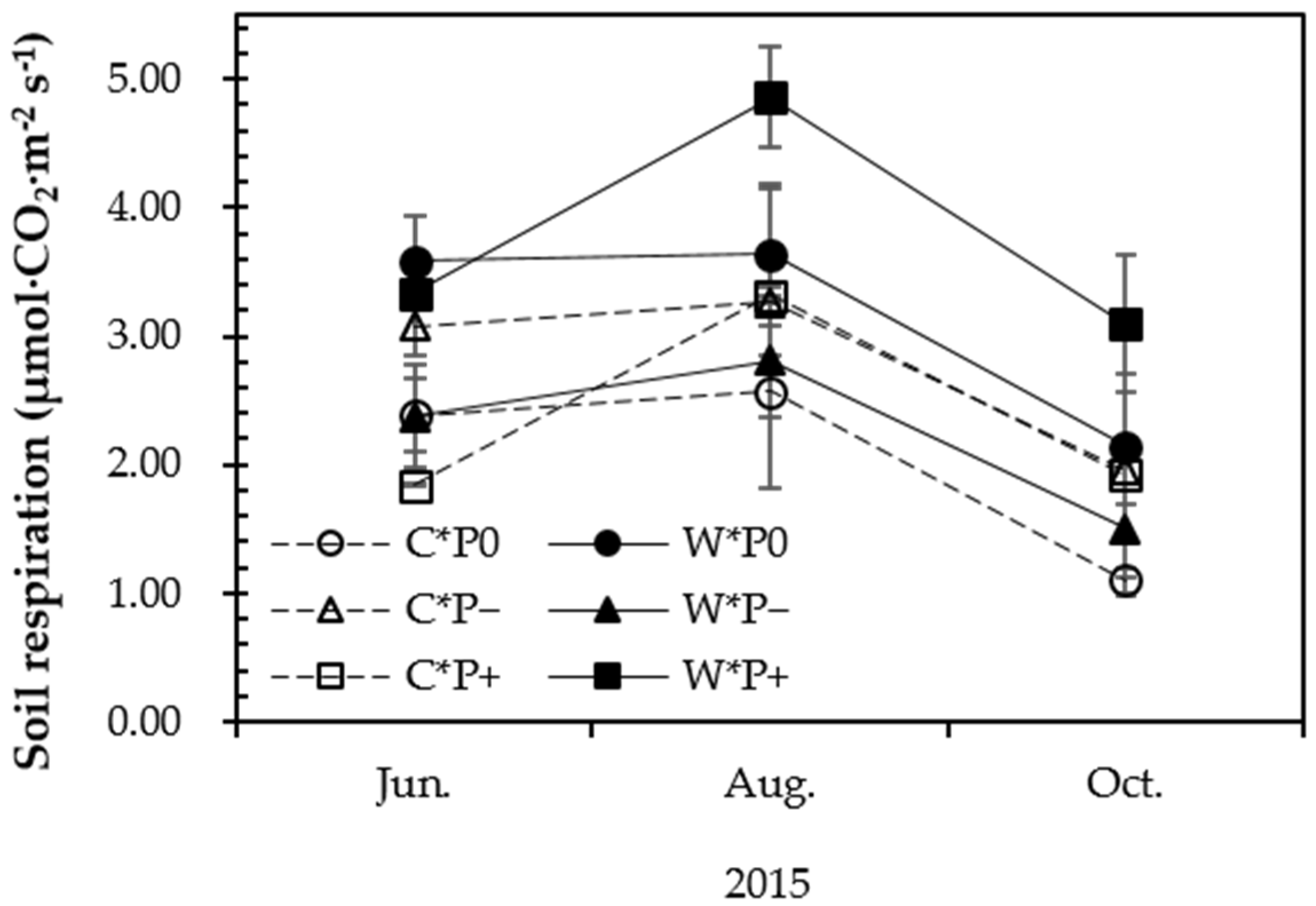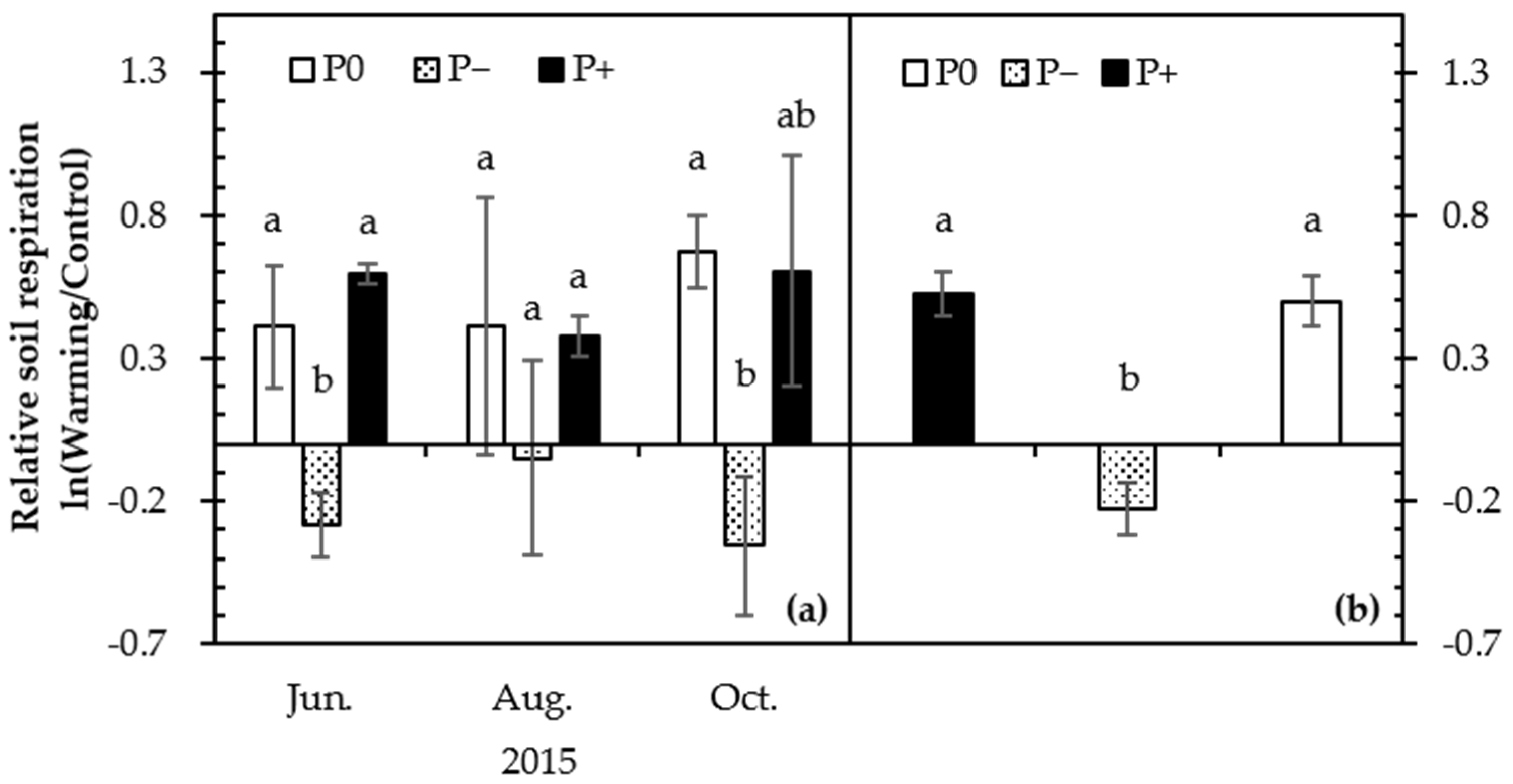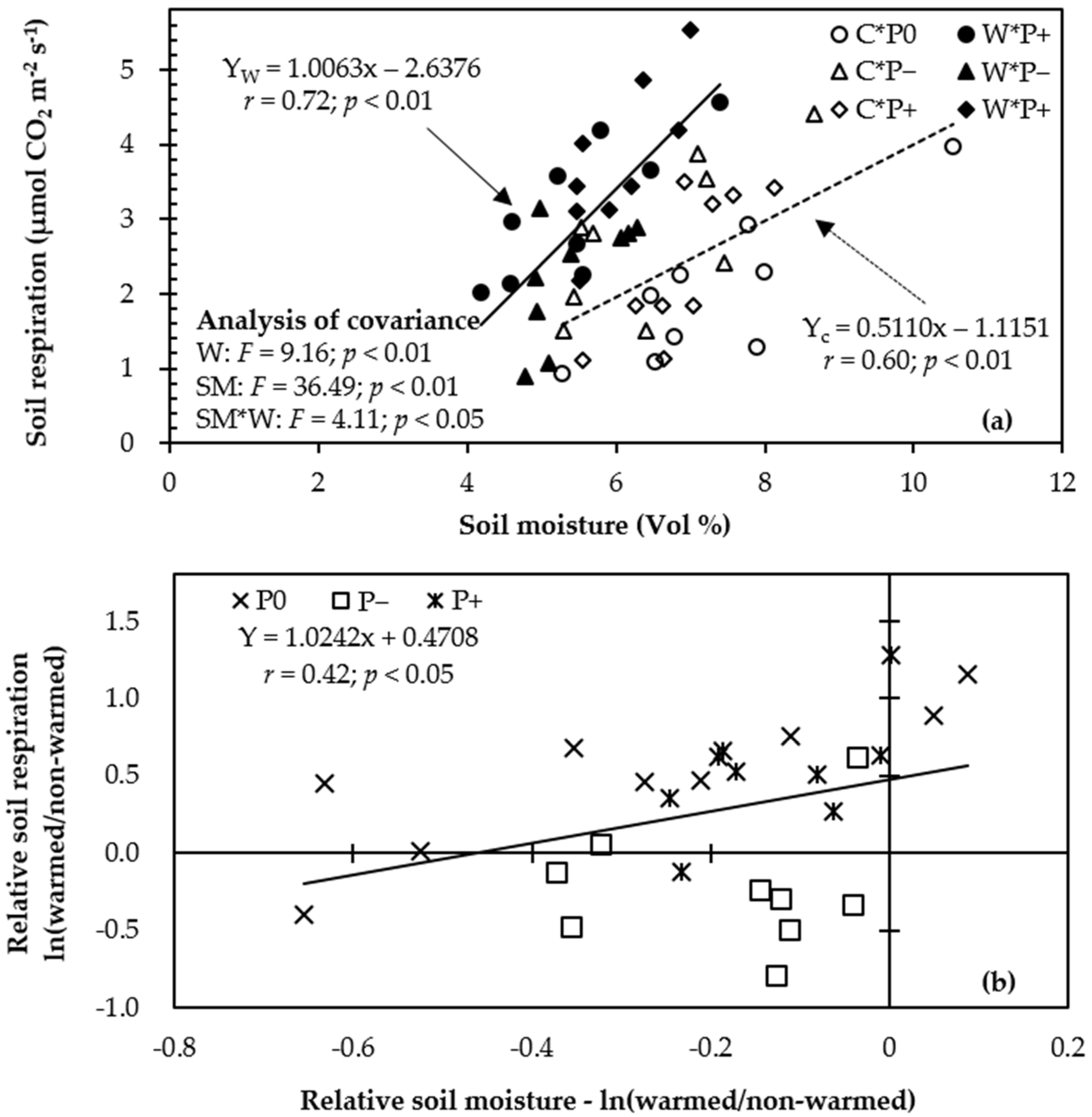Effect of Soil Moisture on the Response of Soil Respiration to Open-Field Experimental Warming and Precipitation Manipulation
Abstract
:1. Introduction
2. Materials and Methods
2.1. Experimental Design
2.2. Field Measurements
2.3. Statistical Analysis
3. Results
3.1. Soil Temperature and Moisture
3.2. Treatment Effects on RS
3.3. Correlations Between RS and Soil Moisture
4. Discussion
4.1. Effects of Treatments on RS
4.2. Soil Moisture and Warming Effect on RS
5. Conclusions
Acknowledgments
Author Contributions
Conflicts of Interest
Appendix A
| Month | Treatment | AT | ST | SM | RS |
|---|---|---|---|---|---|
| (°C) | (°C) | (Vol %) | (μmol·CO2·m−2 s−1) | ||
| June | C*P0 | 23.22 ± 0.24 | 23.91 ± 0.33 | 7.03 ± 0.39 | 2.39 ± 0.28 |
| W*P0 | 26.16 ± 0.56 | 25.09 ± 0.39 | 5.20 ± 0.34 | 3.58 ± 0.35 | |
| C*P− | 23.49 ± 0.19 | 24.72 ± 0.12 | 6.14 ± 0.54 | 3.08 ± 0.23 | |
| W*P− | 26.45 ± 0.41 | 25.18 ± 0.36 | 4.94 ± 0.02 | 2.38 ± 0.41 | |
| C*P+ | 23.17 ± 0.11 | 24.03 ± 0.29 | 6.64 ± 0.22 | 1.84 ± 0.00 | |
| W*P+ | 26.30 ± 0.01 | 24.72 ± 0.21 | 5.87 ± 0.21 | 3.34 ± 0.11 | |
| August | C*P0 | 25.16 ± 0.20 | 25.26 ± 0.10 | 8.43 ± 1.10 | 2.57 ± 0.75 |
| W*P0 | 28.65 ± 1.54 | 25.58 ± 0.22 | 6.45 ± 0.56 | 3.63 ± 0.55 | |
| C*P− | 25.67 ± 0.00 | 25.69 ± 0.14 | 7.39 ± 0.67 | 3.26 ± 0.89 | |
| W*P− | 27.27 ± 1.04 | 25.93 ± 0.19 | 6.18 ± 0.06 | 2.81 ± 0.04 | |
| C*P+ | 25.21 ± 0.07 | 25.65 ± 0.12 | 7.67 ± 0.25 | 3.32 ± 0.06 | |
| W*P+ | 28.08 ± 0.46 | 25.87 ± 0.05 | 6.73 ± 0.19 | 4.86 ± 0.39 | |
| October | C*P0 | 14.68 ± 0.05 | 16.22 ± 0.42 | 6.56 ± 0.75 | 1.10 ± 0.10 |
| W*P0 | 17.53 ± 1.32 | 16.63 ± 0.16 | 4.78 ± 0.41 | 2.14 ± 0.07 | |
| C*P− | 14.74 ± 0.28 | 16.68 ± 0.26 | 6.06 ± 0.70 | 1.95 ± 0.26 | |
| W*P− | 17.20 ± 0.00 | 16.84 ± 0.59 | 5.09 ± 0.18 | 1.50 ± 0.52 | |
| C*P+ | 14.63 ± 0.27 | 16.56 ± 0.29 | 6.37 ± 0.42 | 1.92 ± 0.79 | |
| W*P+ | 17.30 ± 0.58 | 16.97 ± 0.35 | 5.52 ± 0.02 | 3.10 ± 0.53 |
| Repeated measures ANOVA | data RMANOVA; | |
| do P = ‘n’, ‘d’, ‘I’; | /P = precipitation manipulation; n = precipitation control; | |
| d = reduced precipitation; i = elevated precipitation/ | ||
| do T = ‘c’, ‘w’; | /T = warming; c = atmospheric temperature control; | |
| w = atmospheric warming/ | ||
| do s = 1 to 3; | ||
| input M1–M3; | /month/ | |
| output; end; end; end; cards; | ||
| proc glm; class P T; model M1–M3 = P T P*T/nouni; | ||
| repeated t 3 (6 8 10) contrast (1)/summary printe; run; | ||
| Fisher’s least significant difference (LSD) test | data LSD; | |
| do a = 1 to 6; | /a = Treatment/ | |
| do i = 1 to 3; | ||
| input x @@; output; end; end; cards; | ||
| proc anova; class a; model x = a; means a/LSD; run; | ||
| Analysis of Linear regression | data regression; | |
| input ST SM RS @@; | /ST = soil temperature; SM = soil moisture; RS = CO2 efflux/ | |
| cards; | ||
| proc corr pearson; var ST SM RS; run; | ||
| Analysis of covariance | data covariance; | |
| input T $ RS ST SM @@; | /T = warming; ST = soil temperature; SM = soil moisture; | |
| RS = CO2 efflux/ | ||
| cards; | ||
| proc sort; by T; run; | ||
| proc glm; class T; model RS = T|SM; run; | ||
References
- IPCC. Climate Change 2013: The Physical Science Basis: Working Group I Contribution to the Fifth Assessment Report of the Intergovernmental Panel on Climate Change; Cambridge University Press: Cambridge, UK, 2014. [Google Scholar]
- Haghshenas, M.; Mohadjer, M.R.M.; Attarod, P.; Pourtahmasi, K.; Feldhaus, J.; Sadeghi, S.M.M. Climate effect on tree-ring widths of Fagus orientalis in the Caspian forests, northern Iran. For. Sci. Technol. 2016, 12, 176–182. [Google Scholar] [CrossRef]
- Lim, S.J.; Park, H.J.; Kim, H.S.; Park, S.I.; Han, S.S.; Kim, H.J.; Lee, S.H. Vulnerability assessment of forest landslide risk using GIS adaptation to climate change. For. Sci. Technol. 2016, 12, 207–213. [Google Scholar] [CrossRef]
- Liu, T.; Xu, Z.Z.; Hou, Y.H.; Zhou, G.S. Effects of warming and changing precipitation rates on soil respiration over two years in a desert steppe of northern China. Plant Soil 2016, 400, 15–27. [Google Scholar] [CrossRef]
- Schindlbacher, A.; Wunderlich, S.; Borken, W.; Kitzler, B.; Zechmeister-Boltenstern, S.; Jandl, R. Soil respiration under climate change: Prolonged summer drought offsets soil warming effects. Glob. Chang. Biol. 2012, 18, 2270–2279. [Google Scholar] [CrossRef]
- Liu, Y.; Liu, S.; Wan, S.; Wang, J.; Luan, J.; Wang, H. Differential responses of soil respiration to soil warming and experimental throughfall reduction in a transitional oak forest in central China. Agric. For. Meteorol. 2016, 226, 186–198. [Google Scholar] [CrossRef]
- Bao, X.; Zhu, X.; Chang, X.; Wang, S.; Xu, B.; Luo, C.; Zhang, Z.; Wang, Q.; Rui, Y.; Cui, X. Effects of soil temperature and moisture on soil respiration on the Tibetan Plateau. PLoS ONE 2016, 11, e0165212. [Google Scholar] [CrossRef] [PubMed]
- Noh, N.J.; Kuribayashi, M.; Saitoh, T.M.; Nakaji, T.; Nakamura, M.; Hiura, T.; Muraoka, H. Responses of soil, heterotrophic, and autotrophic respiration to experimental open-field soil warming in a cool-temperate deciduous forest. Ecosystems 2016, 19, 504–520. [Google Scholar] [CrossRef]
- Noh, N.J.; Lee, S.J.; Jo, W.; Han, S.; Yoon, T.K.; Chung, H.; Son, Y. Effects of experimental warming on soil respiration and biomass in Quercus variabilis Blume and Pinu sdensiflora Sieb. et Zucc. seedlings. Ann. For. Sci. 2016, 73, 533–545. [Google Scholar] [CrossRef]
- Zhong, Z.M.; Shen, Z.X.; Fu, G. Response of soil respiration to experimental warming in a highland barley of the Tibet. SpringerPlus 2016, 5, 137. [Google Scholar] [CrossRef] [PubMed]
- Wertin, T.M.; Belnap, J.; Reed, S.C. Experimental warming in a dryland community reduced plant photosynthesis and soil CO2 efflux although the relationship between the fluxes remained unchanged. Funct. Ecol. 2016. [Google Scholar] [CrossRef]
- Liu, L.; Wang, X.; Lajeunesse, M.J.; Miao, G.; Piao, S.; Wan, S.; Wu, Y.; Wang, Z.; Yang, S.; Li, P.; et al. A cross-biome synthesis of soil respiration and its determinants under simulated precipitation changes. Glob. Chang. Biol. 2016, 22, 1394–1405. [Google Scholar] [CrossRef] [PubMed]
- Sharkhuu, A.; Plante, A.F.; Enkhmandal, O.; Gonneau, C.; Casper, B.B.; Boldgiv, B.; Petraitis, P.S. Soil and ecosystem respiration responses to grazing, watering and experimental warming chamber treatments across topographical gradients in northern Mongolia. Geoderma 2016, 269, 91–98. [Google Scholar] [CrossRef]
- Feng, J.; Wang, J.; Ding, L.; Yao, P.; Qiao, M.; Yao, S. Meta-analyses of the effects of major global change drivers on soil respiration across China. Atmos. Environ. 2017, 150, 181–186. [Google Scholar] [CrossRef]
- Yun, S.J.; Han, S.; Han, S.H.; Kim, S.; Li, G.L.; Park, M.; Son, Y. Short-term effects of warming treatment and precipitation manipulation on the ecophysiological responses of Pinus densiflora seedlings. Turk. J. Agric. For. 2016, 40, 621–630. [Google Scholar] [CrossRef]
- Park, M.J. Effects of Open-Field Artificial Warming and Precipitation Manipulation on Physiological Characteristics and Growth of Pinus densiflora Seedlings. Master’s Thesis, Korea University, Seoul, Korea, 2016. [Google Scholar]
- Li, G.L.; Kim, S.; Park, M.J.; Son, Y. Short-term effects of experimental warming and precipitation manipulation on soil microbial biomass, substrate utilization patterns, and community composition. Pedosphere 2017, in press. [Google Scholar]
- Wei, X.; Zhang, Y.; Liu, J.; Gao, H.; Fan, J.; Jia, X.; Cheng, J.; Shao, M.; Zhang, X. Response of soil CO2 efflux to precipitation manipulation in a semiarid grassland. J. Environ. Sci. 2016, 45, 207–214. [Google Scholar] [CrossRef] [PubMed]
- Yun, S.J.; Han, S.; Han, S.H.; Lee, S.J.; Jung, Y.; Kim, S.; Son, Y. Open-field experimental warming and precipitation manipulation system design to simulate climate change impact. J. Korean For. Soc. 2014, 103, 159–164. [Google Scholar] [CrossRef]
- Akinremi, O.O.; McGinn, S.M.; McLean, H.D.J. Effects of soil temperature and moisture on soil respiration in barley and fallow plots. Can. J. Soil Sci. 1999, 79, 5–13. [Google Scholar] [CrossRef]
- Jarvi, M.P.; Burton, A.J. Acclimation and soil moisture constrain sugar maple respiration in experimentally warmed soil. Tree Physiol. 2013, 33, 949–959. [Google Scholar] [CrossRef] [PubMed]
- Van Meeteren, M.J.M.; Tietema, A.; van Loon, E.E.; Verstraten, J.M. Microbial dynamics and litter decomposition under a changed climate in a Dutch heathland. Appl. Soil Ecol. 2008, 38, 119–127. [Google Scholar] [CrossRef]
- Geng, S.M.; Yan, D.H.; Zhang, T.X.; Weng, B.S.; Zhang, Z.B.; Gang, W. Effects of extreme drought on agriculture soil and sustainability of different drought soil. Hydrol. Earth Syst. Sci. Discuss. 2014, 11, 1–29. [Google Scholar] [CrossRef]
- Williams, M.A. Response of microbial communities to water stress in irrigated and drought-prone tallgrass prairie soils. Soil Biol. Biochem. 2007, 39, 2750–2757. [Google Scholar] [CrossRef]
- Chang, C.T.; Sperlich, D.; Sabaté, S.; Sánchez-Costa, E.; Cotillas, M.; Espelta, J.M.; Gracia, C. Mitigating the stress of drought on soil respiration by selective thinning: Contrasting effects of drought on soil respiration of two oak species in a Mediterranean forest. Forests 2016, 7, 263. [Google Scholar] [CrossRef]
- Kim, D.H.; Kim, J.H.; Park, J.H.; Ewane, E.B.; Lee, D.H. Correlation between above-ground and below-ground biomass of 13-year-old Pinus densiflora S. et Z. planted in a post-fire area in Samcheok. For. Sci. Technol. 2016, 12, 115–124. [Google Scholar]



| Effect | df | ST | SM | RS | ||||||
|---|---|---|---|---|---|---|---|---|---|---|
| F | p | F | p | F | p | |||||
| Warming (W) | 1 | 6.1900 | 0.0285 | * | 12.060 | 0.0046 | ** | 6.4500 | 0.0259 | * |
| Precipitation (P) | 2 | 1.5400 | 0.2535 | ns | 0.7300 | 0.5019 | ns | 1.8800 | 0.1948 | ns |
| Month (M) | 2 | 2924.7 | <0.0001 | ** | 89.360 | <0.0001 | ** | 22.620 | <0.0001 | ** |
| W × P | 2 | 0.3100 | 0.7397 | ns | 0.6700 | 0.5293 | ns | 5.4300 | 0.0209 | * |
| W × M | 2 | 2.3800 | 0.1138 | ns | 0.3000 | 0.7451 | ns | 0.0500 | 0.9553 | ns |
| P × M | 4 | 1.2200 | 0.3304 | ns | 1.7300 | 0.1763 | ns | 2.3900 | 0.0786 | ns |
| W × P × M | 4 | 0.3300 | 0.8565 | ns | 0.0800 | 0.9869 | ns | 0.1000 | 0.9831 | ns |
| Variables | C*P0 | W*P0 | C*P− | W*P− | C*P+ | W*P+ |
|---|---|---|---|---|---|---|
| AT (°C) | 21.02 ± 3.22 a | 24.11 ± 3.37 a | 21.30 ± 3.34 a | 23.64 ± 3.23 a | 21.00 ± 3.24 a | 23.90 ± 3.34 a |
| ST (°C) | 21.80 ± 2.82 a | 22.43 ± 2.90 a | 22.36 ± 2.86 a | 22.65 ± 2.91 a | 22.08 ± 2.80 a | 22.52 ± 2.79 a |
| SM (Vol %) | 7.34 ± 0.56 a | 5.47 ± 0.50 b | 6.53 ± 0.43 ab | 5.40 ± 0.39 b | 6.90 ± 0.39 a | 6.04 ± 0.36 ab |
| RS (μmol·CO2·m−2 s−1) | 2.02 ± 0.46 a | 3.12 ± 0.49 ab | 2.76 ± 0.41 ab | 2.23 ± 0.38 a | 2.36 ± 0.48 ab | 3.76 ± 0.55 b |
© 2017 by the authors. Licensee MDPI, Basel, Switzerland. This article is an open access article distributed under the terms and conditions of the Creative Commons Attribution (CC BY) license ( http://creativecommons.org/licenses/by/4.0/).
Share and Cite
Li, G.; Kim, S.; Han, S.H.; Chang, H.; Son, Y. Effect of Soil Moisture on the Response of Soil Respiration to Open-Field Experimental Warming and Precipitation Manipulation. Forests 2017, 8, 56. https://doi.org/10.3390/f8030056
Li G, Kim S, Han SH, Chang H, Son Y. Effect of Soil Moisture on the Response of Soil Respiration to Open-Field Experimental Warming and Precipitation Manipulation. Forests. 2017; 8(3):56. https://doi.org/10.3390/f8030056
Chicago/Turabian StyleLi, Guanlin, Seongjun Kim, Seung Hyun Han, Hanna Chang, and Yowhan Son. 2017. "Effect of Soil Moisture on the Response of Soil Respiration to Open-Field Experimental Warming and Precipitation Manipulation" Forests 8, no. 3: 56. https://doi.org/10.3390/f8030056






